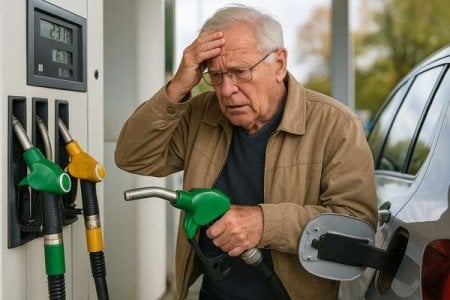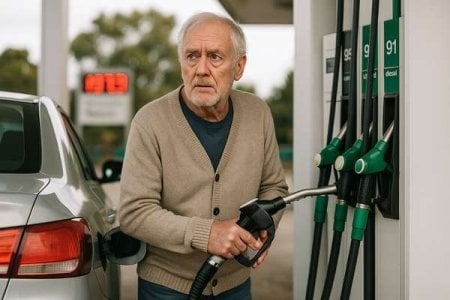A 'hidden' price pinch could quietly hit your wallets this week! Are you ready to pump out extra cash?
By
Danielle G.
- Replies 0
Australians pulling up to the bowser this week may notice their fuel bill creeping higher, and it’s not just global oil prices to blame. A little-known increase in the federal fuel excise – effectively a “hidden tax” on every litre of petrol or diesel – has quietly kicked in, adding to our cost-of-living squeeze. The excise on fuel rose from 50.8 cents to 51.6 cents per litre as of Monday, in line with the government’s routine CPI indexation. Now, 51.6 cents of every litre – about a quarter of the current pump price – is tax. For retirees and pensioners on fixed incomes, that extra fraction of a cent can feel like salt in the wound when you’re already paying close to $1.80–$2.00+ per litre in many areas. It’s enough to make you double-check if you squeezed every drop in, or even consider dusting off the old bicycle (though perhaps not ideal for our knees these days).
Most Australians don’t see the fuel excise; it’s built into the price on the service station sign, making it essentially invisible – a tax we pay without realising. Introduced decades ago to help fund road infrastructure, the excise has grown over time and is adjusted twice a year in line with inflation. (Many older readers might recall when petrol was measured in gallons and a few cents of tax was hardly noticeable – those days are long gone.) In fact, from 2001 to 2014 the excise was frozen, but since then it’s been rising steadily again with inflation. This latest indexation bump of 1.5% may sound minor, but these regular hikes add up.
Critics point out that fuel excise is a “tax on a tax” – not only do we pay 51.6c per litre to the government, but we also pay 10% GST on the total price, which includes that excise. In other words, we’re taxed, then taxed again. “It’s a clear double dip by the Federal Government,” says Victorian Automobile Chamber of Commerce CEO Peter Jones, noting motorists are slugged with excise and then GST on top. Little wonder some argue Australian fuel costs are higher than they should be. (Though for perspective, Australia still has one of the lower fuel tax takes in the developed world – about 50c/L in taxes here versus some countries where taxes make up half the pump price.)
Where does all that money go? In theory, into roads and transport projects. But only 57% of fuel excise revenue was spent on land transport in the last decade – the rest vanished into general government coffers. So if you’ve ever felt skeptical that your petrol taxes are fixing that pothole on your street, you’re not entirely wrong. Government revenue from the fuel excise is actually forecast to grow in coming years (to around $17.7 billion by 2026-27), even as many of us drive less or consider more efficient cars. For now, the excise remains a lucrative – if sneaky – source of funds, and it climbs automatically every six months with barely a peep unless you’re paying close attention.
Beyond taxes, petrol prices have been on a rollercoaster that older Aussies know all too well. In the first part of this year, average unleaded prices across our big cities hovered around $1.80 per litre – high by historical standards, though a bit below the peaks seen in the past couple of years. Of course, prices fluctuate in weekly cycles and by location: if you fill up on the wrong day in Brisbane, for example, you might have been stung by prices over $2.20/L recently. In fact, one Queensland motoring body reported prices jumping from 179.9c to 229.9c per litre in a single week at some sites, as servos jacked up margins. For someone on a pension, an unexpected 50¢ hike is not just a mild inconvenience – it’s a genuine hit to the budget.
So what’s driving these dizzying prices? A mix of international and local factors. Global oil and refined petrol costs (which depend on everything from OPEC’s mood swings to the Aussie dollar exchange rate) play a big role. The ACCC noted that a weaker Australian dollar in early 2025 kept pump prices higher than they otherwise would be. Local competition (or lack thereof) is another factor – if there’s only one petrol station in town, you’re at their mercy. And then there’s the aforementioned tax component creeping up in the background. All this means there’s no quick relief in sight; if anything, forecasts suggest prices will remain elevated or even rise further if global conditions worsen.
Government and consumer groups are certainly aware of the pressure. National Seniors Australia – an advocacy group for older Australians – has even called for temporary cuts to the fuel excise to ease cost-of-living stress. They argue that when nearly 50 cents of every litre you buy is tax, trimming that tax (even for a while) could provide meaningful relief. It happened once before: in 2022, a short-lived excise holiday halved the tax for a few months. But that relief proved fleeting, and the excise crept back up. For now, the best advice for petrol buyers is the same as always: shop around, time your fill-ups for the cheaper part of the price cycle if you can, and maybe avoid driving the V8 gas-guzzler too often.
With petrol prices and taxes climbing, you might be eyeing those shiny electric vehicles (EVs) or hybrids and wondering: “Would switching save me money or just give me new headaches?” It’s a great question, especially for retirees. After all, many of us drive less than we used to, and we’re watching our spending carefully. The short answer is hybrids and EVs can save you money on running costs, but the upfront price tag and practical considerations are the tricky part. Let’s break it down.
Hybrids (like a Toyota Corolla Hybrid or Honda Civic e:HEV) use a petrol engine plus an electric motor to cut fuel use. They don’t need to be plugged in, and you fuel them up just like a normal car – you’ll just be visiting the servo a lot less. Many hybrids deliver 30-50% better fuel economy than their petrol-only counterparts, so your petrol bill drops accordingly. For example, if you normally spend $50 a week on petrol, a hybrid might cut that to ~$25–$35. Over a year, those savings could be well over $700. Maintenance for hybrids is similar to regular cars (they still have engines, after all), but regenerative braking means brake pads last longer, and the engine has an easier life. The purchase price of a hybrid is usually a few thousand dollars more than a standard car. The question is whether fuel savings over, say, 5-10 years will repay that difference. For many drivers doing moderate kilometres, it can – and unlike a full EV, you don’t need to worry about installing chargers or finding charging stations. Australian buyers seem to like this middle-ground approach: hybrid vehicle sales now even outnumber electric vehicle sales in recent figures, suggesting many are taking the “step-by-step” path to cleaner, cheaper driving.
Electric Vehicles (EVs), on the other hand, promise zero petrol bills and lower maintenance costs (no oil changes or engine tune-ups). The trade-off: higher upfront cost and reliance on charging. EVs are significantly cheaper to run per kilometre – some estimates say fuel (electricity) costs can be 70% less, and maintenance around 40% less than a comparable petrol car, thanks to far fewer moving parts. We heard one real-world example from Perth: 95-year-old Chas Renner switched to an electric MG and found it cost only about $60–$100 in electricity for two months of driving, whereas he used to pay about $50 per week for petrol. For him, that’s a massive difference – roughly one-quarter the running cost – and he’s now a passionate advocate for more seniors to go electrict. “When someone says ‘what are you doing getting an electric car at your age,’ I tell them I’ve had a lot of cars in my life and I’m going out with an electric one,” the former electrician quips.
Those savings sound enticing, but let’s consider the bigger picture. Upfront costs for EVs remain steep in Australia. The cheapest new electric cars (think small models like the MG ZS EV or Nissan Leaf) still hover around $40,000 or more, which is a lot if you’re on retirement income. Popular models like a Tesla will set you back $60k and up. In comparison, you can get a comfortable small petrol car or hybrid for $25k–$35k. That price gap can buy a lot of petrol. As James Voortman of the Australian Automotive Dealer Association notes, “premium prices amid a cost-of-living crisis” make many consumers wary – three in five people say they’re not willing to pay extra for an EV right now. It’s hard to justify the higher sticker price when “during this time where everything is costing more” it’s difficult to look beyond the immediate hit to your wallet for the future fuel savings. For an older Australian, the payback period of an EV (how long before fuel and maintenance savings cover the higher purchase price) might be longer than you intend to keep driving altogether.
Usage patterns matter too. If you only drive the local area for shopping and appointments, doing, say, 5,000 km a year, your annual petrol usage might not be that high to begin with. The less you drive, the longer it takes for an EV’s savings to add up. On the flip side, if you enjoy road trips or caravanning in retirement, petrol costs can really bite – but here an EV faces another challenge: charging and range. Australia’s charging infrastructure is improving, with more fast-chargers along highways each month, yet it’s uneven. In cities and major highways, you’ll generally find a charger when you need one (though you might have to plan a coffee break around charging). In rural or outback areas, stations are sparse. Mr Renner in WA loves his EV for city driving but noted “the only downside is the number of charging stations... if you go inland there’s not that many”. For retirees in regional Australia, that’s a real consideration – nobody wants to be stranded with a flat battery miles from help.
Home charging is the ideal for EV owners: plug in overnight in your garage, wake up to a full “tank” each morning. Many older Australians live in houses where installing a home charger (around $1,000–$2,000 cost) is feasible, especially if they have solar panels to supply free energy. But those in apartments or retirement villages might not have a private garage or the body-corporate approval to put in a charger. Not everyone has access to convenient home charging yet, which is a hurdle that will diminish over time as infrastructure catches up, but it’s worth thinking about before making the leap to electric.
And then there’s the learning curve. Modern cars – especially EVs – are essentially computers on wheels. Jumping from a familiar older Camry into a high-tech EV can feel overwhelming at first. (Chas compared it to “getting a new phone” and having to figure out the gadgets.) However, many seniors find that after a little orientation, an EV can actually be simpler to operate day-to-day – no gears to shift, no engine vibration, just a quiet, smooth ride. It might even be fun to silently zip past the petrol station where you used to spend $100+. The key is doing what you’re comfortable with: some retirees absolutely love their hybrids or EVs and the freedom from fuel anxiety, while others prefer sticking with what they know for now.
You might be thinking, “This all sounds great, but can anyone give me a hand with these costs?” The good news is there are a few government incentives and programs that can help – though it can be a bit of a patchwork depending on where you live.
For those sticking with petrol or hybrid vehicles, some state governments recognise the pinch at the pump for seniors. In New South Wales, for instance, the government recently partnered with a petrol company to offer Seniors Card holders a 4 cents per litre discount on fuel, after controversially suspending a $250 regional travel card scheme. It’s not a huge saving (around $2.40 off a full 60L tank – as one critic noted, far less generous than the old $250 card), but every little bit helps. In Western Australia, the state government provides a Regional Pensioner Travel Card worth up to $675 a year for fuel or taxi fares for eligible country pensioners, acknowledging that rural seniors often have to drive long distances for essentials. Additionally, seniors nationwide typically enjoy discounts or concessions on vehicle registration and licensing in most states, which can take some sting out of annual car ownership costs.
When it comes to buying an EV or hybrid, there are also incentives to make it easier. At the federal level, there’s an Electric Car Discount scheme – essentially a fringe-benefits tax exemption that makes EVs cheaper if you salary-sacrifice or lease one through your employer. That’s great if you’re still working or have that option, but it doesn’t directly help a retiree who’s buying a car outright. State governments have offered various carrots: rebates and tax breaks on new EV purchases have been available in many states and territories. For example, Western Australia offers a $3,500 rebate for new EVs under $70k, and Tasmania provides $2,000 for new or used EVs. Other states have provided stamp duty waivers or registration discounts for EVs and even some hybrids. However, be aware these programs have been evolving – some, like NSW’s $3,000 rebate, have already ended as EV uptake increasese. It’s worth checking what’s on offer in your state at the time you’re car shopping. The incentives can shave a few thousand off the price, which might tip the balance when deciding whether to go electric.
There’s also the broader support of improving infrastructure: government grants for more charging stations, and strategies to ensure the shift to EVs is manageable. The federal government’s new National Electric Vehicle Strategy is aimed at increasing model availability and setting fuel efficiency standards for carmakers, which should, over time, bring more affordable EV options to our shores. And as charging networks expand (for example, WA is rolling out the country’s longest EV charging highway with nearly 100 charge points across the state), the practical usability of EVs will only get better for people in all corners of Australia.
At the end of the day, whether you stick with your trusty petrol car, opt for a fuel-sipping hybrid, or make the jump to an electric vehicle, it’s clear that the landscape for Aussie motorists is changing. The fuel excise tax will keep nudging up twice a year – a little “happy new year” and “happy new financial year” gift from the government – and petrol likely won’t get dramatically cheaper for long stretches as it sometimes did in decades past. Many retirees will rightly feel aggrieved that a “hidden” tax hike is hitting their wallets without much fanfare. Others might take it as a prompt to finally consider that new-tech car to reduce dependency on expensive petrol. There’s no one-size-fits-all answer. For some, an EV or hybrid will make perfect sense and deliver real savings and peace of mind; for others, the upfront cost or practical limitations might outweigh the benefits at this stage.
The great news is that we have more choices than ever – and even at age 60, 70 or beyond, you’re not too old to embrace a new kind of motoring if it suits you. As 95-year-old EV driver Mr Renner showed, you can teach an old dog new tricks (his words, not ours!), and it might even be enjoyable. But whether you’re excited about electric cars or simply hoping the government might throw drivers a bone by easing fuel taxes, one thing’s for sure: we’ll all be watching those price boards with keen eyes. It might be a good time to ask ourselves and our leaders – is it time to rethink how we get around and what we drive, or should we be pushing for more immediate relief at the petrol pump? (After all, we seniors have seen it all, and we know a thing or two about planning for the long haul.) What do you think – is going electric the way to go, or should we demand a better deal on petrol for those of us who grew up with the roar of an engine?

Read more:
Cars Behaving Badly: Why Your “Fuel-Efficient” Car Might Be Guzzling More Than Promised
Discount partnership offers cost of living relief for older Aussies
Petrol is cheaper than ever in these five major cities! See how low prices have gone
The Fuel Excise 101: A Brief History and How It Works
Most Australians don’t see the fuel excise; it’s built into the price on the service station sign, making it essentially invisible – a tax we pay without realising. Introduced decades ago to help fund road infrastructure, the excise has grown over time and is adjusted twice a year in line with inflation. (Many older readers might recall when petrol was measured in gallons and a few cents of tax was hardly noticeable – those days are long gone.) In fact, from 2001 to 2014 the excise was frozen, but since then it’s been rising steadily again with inflation. This latest indexation bump of 1.5% may sound minor, but these regular hikes add up.
Critics point out that fuel excise is a “tax on a tax” – not only do we pay 51.6c per litre to the government, but we also pay 10% GST on the total price, which includes that excise. In other words, we’re taxed, then taxed again. “It’s a clear double dip by the Federal Government,” says Victorian Automobile Chamber of Commerce CEO Peter Jones, noting motorists are slugged with excise and then GST on top. Little wonder some argue Australian fuel costs are higher than they should be. (Though for perspective, Australia still has one of the lower fuel tax takes in the developed world – about 50c/L in taxes here versus some countries where taxes make up half the pump price.)
Where does all that money go? In theory, into roads and transport projects. But only 57% of fuel excise revenue was spent on land transport in the last decade – the rest vanished into general government coffers. So if you’ve ever felt skeptical that your petrol taxes are fixing that pothole on your street, you’re not entirely wrong. Government revenue from the fuel excise is actually forecast to grow in coming years (to around $17.7 billion by 2026-27), even as many of us drive less or consider more efficient cars. For now, the excise remains a lucrative – if sneaky – source of funds, and it climbs automatically every six months with barely a peep unless you’re paying close attention.
Petrol Price Trends: Pain at the Pump
Beyond taxes, petrol prices have been on a rollercoaster that older Aussies know all too well. In the first part of this year, average unleaded prices across our big cities hovered around $1.80 per litre – high by historical standards, though a bit below the peaks seen in the past couple of years. Of course, prices fluctuate in weekly cycles and by location: if you fill up on the wrong day in Brisbane, for example, you might have been stung by prices over $2.20/L recently. In fact, one Queensland motoring body reported prices jumping from 179.9c to 229.9c per litre in a single week at some sites, as servos jacked up margins. For someone on a pension, an unexpected 50¢ hike is not just a mild inconvenience – it’s a genuine hit to the budget.
So what’s driving these dizzying prices? A mix of international and local factors. Global oil and refined petrol costs (which depend on everything from OPEC’s mood swings to the Aussie dollar exchange rate) play a big role. The ACCC noted that a weaker Australian dollar in early 2025 kept pump prices higher than they otherwise would be. Local competition (or lack thereof) is another factor – if there’s only one petrol station in town, you’re at their mercy. And then there’s the aforementioned tax component creeping up in the background. All this means there’s no quick relief in sight; if anything, forecasts suggest prices will remain elevated or even rise further if global conditions worsen.
Government and consumer groups are certainly aware of the pressure. National Seniors Australia – an advocacy group for older Australians – has even called for temporary cuts to the fuel excise to ease cost-of-living stress. They argue that when nearly 50 cents of every litre you buy is tax, trimming that tax (even for a while) could provide meaningful relief. It happened once before: in 2022, a short-lived excise holiday halved the tax for a few months. But that relief proved fleeting, and the excise crept back up. For now, the best advice for petrol buyers is the same as always: shop around, time your fill-ups for the cheaper part of the price cycle if you can, and maybe avoid driving the V8 gas-guzzler too often.
The Shift to Hybrids and EVs: Worth It for Retirees?
With petrol prices and taxes climbing, you might be eyeing those shiny electric vehicles (EVs) or hybrids and wondering: “Would switching save me money or just give me new headaches?” It’s a great question, especially for retirees. After all, many of us drive less than we used to, and we’re watching our spending carefully. The short answer is hybrids and EVs can save you money on running costs, but the upfront price tag and practical considerations are the tricky part. Let’s break it down.
Hybrids (like a Toyota Corolla Hybrid or Honda Civic e:HEV) use a petrol engine plus an electric motor to cut fuel use. They don’t need to be plugged in, and you fuel them up just like a normal car – you’ll just be visiting the servo a lot less. Many hybrids deliver 30-50% better fuel economy than their petrol-only counterparts, so your petrol bill drops accordingly. For example, if you normally spend $50 a week on petrol, a hybrid might cut that to ~$25–$35. Over a year, those savings could be well over $700. Maintenance for hybrids is similar to regular cars (they still have engines, after all), but regenerative braking means brake pads last longer, and the engine has an easier life. The purchase price of a hybrid is usually a few thousand dollars more than a standard car. The question is whether fuel savings over, say, 5-10 years will repay that difference. For many drivers doing moderate kilometres, it can – and unlike a full EV, you don’t need to worry about installing chargers or finding charging stations. Australian buyers seem to like this middle-ground approach: hybrid vehicle sales now even outnumber electric vehicle sales in recent figures, suggesting many are taking the “step-by-step” path to cleaner, cheaper driving.
Electric Vehicles (EVs), on the other hand, promise zero petrol bills and lower maintenance costs (no oil changes or engine tune-ups). The trade-off: higher upfront cost and reliance on charging. EVs are significantly cheaper to run per kilometre – some estimates say fuel (electricity) costs can be 70% less, and maintenance around 40% less than a comparable petrol car, thanks to far fewer moving parts. We heard one real-world example from Perth: 95-year-old Chas Renner switched to an electric MG and found it cost only about $60–$100 in electricity for two months of driving, whereas he used to pay about $50 per week for petrol. For him, that’s a massive difference – roughly one-quarter the running cost – and he’s now a passionate advocate for more seniors to go electrict. “When someone says ‘what are you doing getting an electric car at your age,’ I tell them I’ve had a lot of cars in my life and I’m going out with an electric one,” the former electrician quips.
Those savings sound enticing, but let’s consider the bigger picture. Upfront costs for EVs remain steep in Australia. The cheapest new electric cars (think small models like the MG ZS EV or Nissan Leaf) still hover around $40,000 or more, which is a lot if you’re on retirement income. Popular models like a Tesla will set you back $60k and up. In comparison, you can get a comfortable small petrol car or hybrid for $25k–$35k. That price gap can buy a lot of petrol. As James Voortman of the Australian Automotive Dealer Association notes, “premium prices amid a cost-of-living crisis” make many consumers wary – three in five people say they’re not willing to pay extra for an EV right now. It’s hard to justify the higher sticker price when “during this time where everything is costing more” it’s difficult to look beyond the immediate hit to your wallet for the future fuel savings. For an older Australian, the payback period of an EV (how long before fuel and maintenance savings cover the higher purchase price) might be longer than you intend to keep driving altogether.
Usage patterns matter too. If you only drive the local area for shopping and appointments, doing, say, 5,000 km a year, your annual petrol usage might not be that high to begin with. The less you drive, the longer it takes for an EV’s savings to add up. On the flip side, if you enjoy road trips or caravanning in retirement, petrol costs can really bite – but here an EV faces another challenge: charging and range. Australia’s charging infrastructure is improving, with more fast-chargers along highways each month, yet it’s uneven. In cities and major highways, you’ll generally find a charger when you need one (though you might have to plan a coffee break around charging). In rural or outback areas, stations are sparse. Mr Renner in WA loves his EV for city driving but noted “the only downside is the number of charging stations... if you go inland there’s not that many”. For retirees in regional Australia, that’s a real consideration – nobody wants to be stranded with a flat battery miles from help.
Home charging is the ideal for EV owners: plug in overnight in your garage, wake up to a full “tank” each morning. Many older Australians live in houses where installing a home charger (around $1,000–$2,000 cost) is feasible, especially if they have solar panels to supply free energy. But those in apartments or retirement villages might not have a private garage or the body-corporate approval to put in a charger. Not everyone has access to convenient home charging yet, which is a hurdle that will diminish over time as infrastructure catches up, but it’s worth thinking about before making the leap to electric.
And then there’s the learning curve. Modern cars – especially EVs – are essentially computers on wheels. Jumping from a familiar older Camry into a high-tech EV can feel overwhelming at first. (Chas compared it to “getting a new phone” and having to figure out the gadgets.) However, many seniors find that after a little orientation, an EV can actually be simpler to operate day-to-day – no gears to shift, no engine vibration, just a quiet, smooth ride. It might even be fun to silently zip past the petrol station where you used to spend $100+. The key is doing what you’re comfortable with: some retirees absolutely love their hybrids or EVs and the freedom from fuel anxiety, while others prefer sticking with what they know for now.
Government Sweeteners: Fuel Discounts and EV Incentives
You might be thinking, “This all sounds great, but can anyone give me a hand with these costs?” The good news is there are a few government incentives and programs that can help – though it can be a bit of a patchwork depending on where you live.
For those sticking with petrol or hybrid vehicles, some state governments recognise the pinch at the pump for seniors. In New South Wales, for instance, the government recently partnered with a petrol company to offer Seniors Card holders a 4 cents per litre discount on fuel, after controversially suspending a $250 regional travel card scheme. It’s not a huge saving (around $2.40 off a full 60L tank – as one critic noted, far less generous than the old $250 card), but every little bit helps. In Western Australia, the state government provides a Regional Pensioner Travel Card worth up to $675 a year for fuel or taxi fares for eligible country pensioners, acknowledging that rural seniors often have to drive long distances for essentials. Additionally, seniors nationwide typically enjoy discounts or concessions on vehicle registration and licensing in most states, which can take some sting out of annual car ownership costs.
When it comes to buying an EV or hybrid, there are also incentives to make it easier. At the federal level, there’s an Electric Car Discount scheme – essentially a fringe-benefits tax exemption that makes EVs cheaper if you salary-sacrifice or lease one through your employer. That’s great if you’re still working or have that option, but it doesn’t directly help a retiree who’s buying a car outright. State governments have offered various carrots: rebates and tax breaks on new EV purchases have been available in many states and territories. For example, Western Australia offers a $3,500 rebate for new EVs under $70k, and Tasmania provides $2,000 for new or used EVs. Other states have provided stamp duty waivers or registration discounts for EVs and even some hybrids. However, be aware these programs have been evolving – some, like NSW’s $3,000 rebate, have already ended as EV uptake increasese. It’s worth checking what’s on offer in your state at the time you’re car shopping. The incentives can shave a few thousand off the price, which might tip the balance when deciding whether to go electric.
There’s also the broader support of improving infrastructure: government grants for more charging stations, and strategies to ensure the shift to EVs is manageable. The federal government’s new National Electric Vehicle Strategy is aimed at increasing model availability and setting fuel efficiency standards for carmakers, which should, over time, bring more affordable EV options to our shores. And as charging networks expand (for example, WA is rolling out the country’s longest EV charging highway with nearly 100 charge points across the state), the practical usability of EVs will only get better for people in all corners of Australia.
So… What’s the Best Road Ahead?
At the end of the day, whether you stick with your trusty petrol car, opt for a fuel-sipping hybrid, or make the jump to an electric vehicle, it’s clear that the landscape for Aussie motorists is changing. The fuel excise tax will keep nudging up twice a year – a little “happy new year” and “happy new financial year” gift from the government – and petrol likely won’t get dramatically cheaper for long stretches as it sometimes did in decades past. Many retirees will rightly feel aggrieved that a “hidden” tax hike is hitting their wallets without much fanfare. Others might take it as a prompt to finally consider that new-tech car to reduce dependency on expensive petrol. There’s no one-size-fits-all answer. For some, an EV or hybrid will make perfect sense and deliver real savings and peace of mind; for others, the upfront cost or practical limitations might outweigh the benefits at this stage.
The great news is that we have more choices than ever – and even at age 60, 70 or beyond, you’re not too old to embrace a new kind of motoring if it suits you. As 95-year-old EV driver Mr Renner showed, you can teach an old dog new tricks (his words, not ours!), and it might even be enjoyable. But whether you’re excited about electric cars or simply hoping the government might throw drivers a bone by easing fuel taxes, one thing’s for sure: we’ll all be watching those price boards with keen eyes. It might be a good time to ask ourselves and our leaders – is it time to rethink how we get around and what we drive, or should we be pushing for more immediate relief at the petrol pump? (After all, we seniors have seen it all, and we know a thing or two about planning for the long haul.) What do you think – is going electric the way to go, or should we demand a better deal on petrol for those of us who grew up with the roar of an engine?
Key Takeaways
- Fuel Excise “Hidden Tax” – The federal fuel excise just increased to 51.6¢ per litre, quietly raising petrol and diesel prices. It’s built into pump prices (plus GST on top), meaning drivers pay a tax on a tax. This hits fixed-income seniors and adds to cost-of-living pressures.
- High Petrol Prices & Inflation – Petrol is averaging around $1.80–$2.00/L in many areas, with price spikes over $2.20 due to cycles and retailer margins. Fuel costs are a major factor in inflation and household budgets, leading groups like National Seniors to call for a cut or freeze in fuel excise to ease pressure.
- EVs/Hybrids vs Petrol Costs – Electric vehicles and hybrids can significantly reduce running costs (EV fuel/maintenance up to ~70%/40% cheaper), but they come with higher upfront prices. Many Aussies – especially older drivers – are opting for hybrids as a cost-effective middle step. EVs offer big savings on petrol (e.g. one senior cut fuel costs by ~75% by going electric) but require considering charging access, driving range, and initial investment.
- Incentives & Support – Governments offer some relief: e.g. senior fuel discounts (NSW seniors get 4c/L off at certain servos, WA regional pensioners get a $675 fuel card) and EV incentives (rebates up to $3k–$3.5k in some states, registration and stamp duty discounts). These can help, but programs vary and some have been phased out as EV adoption grows. Always check what’s available in your state before making decisions.
Read more:
Cars Behaving Badly: Why Your “Fuel-Efficient” Car Might Be Guzzling More Than Promised
Discount partnership offers cost of living relief for older Aussies
Petrol is cheaper than ever in these five major cities! See how low prices have gone
Last edited:










